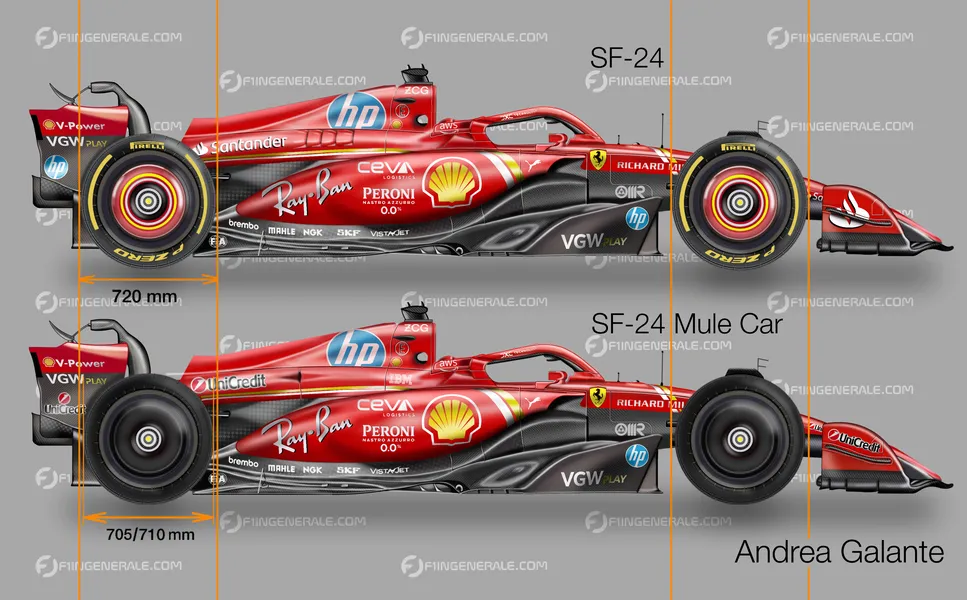
Barcelona already has a style of 2026, with Ferrari and McLaren engaged in a Pirelli check session. The aim was to judge the most recent prototype tires for the 2026 season, that are lighter and smaller in dimension.
Ferrari took to the monitor with the SF-24, giving Lewis Hamilton the chance to familiarize himself with Maranello’s newest single-seater. The adoption of smaller tires required a number of modifications to the automotive, from the suspension—adjusted to accommodate the brand new tires—to aerodynamic adjustments. FIA laws enable groups to make modifications to their vehicles to simulate the estimated aerodynamic load ranges for 2026.
The checks will assist Pirelli perceive how the mule vehicles behave, as groups don’t but bodily have their 2026 vehicles. Nonetheless, Pirelli won’t rely solely on the information collected, as next-generation single-seaters will bear radical technical adjustments that can have an effect on their efficiency.
2026 New Tires
Pictures from the check clearly spotlight the variations in comparison with the present tires. The scale discount stems from the necessity to lighten the carcass and scale back aerodynamic drag.
Whereas sustaining the 18-inch rims, each entrance and rear tires may have altered dimensions. The general diameter will shrink from the present 720 mm to a variety between 705 and 710 mm. The width may also lower: the entrance tire will probably be 25 mm narrower, whereas the rear will lose 30 mm.

Comparability between SF-24 and SF-24 Mule Automobile – Supply: f1ingenerale
Simulating the masses that the 2026 tires should stand up to utilizing modified current-generation vehicles will probably be a problem for Pirelli. Because of this, groups have launched particular aerodynamic options to approximate the anticipated downforce ranges.
Aerodynamics
From the images seen in current days, the low-downforce configuration instantly stands out—an uncommon setup for a technical circuit like Barcelona, which is understood for requiring excessive downforce ranges.
The entrance wing resembles the configuration seen in Las Vegas, one of many least demanding tracks by way of aerodynamic load, albeit with some modifications. On the rear, Ferrari adopted a low-downforce setup just like the one utilized in Monza. The aim was to scale back aerodynamic load by about 20% to simulate the downforce ranges anticipated for 2026.

Supply:1ingenerale
It additionally seems that DRS was extensively used, even in areas of the monitor not usually designated for it throughout a race weekend, to compensate for the entrance and rear load.
Efficiency and 2026 Projections
Lap occasions have been considerably slower, suggesting a efficiency drop for 2026 vehicles. Nonetheless, these knowledge needs to be interpreted cautiously, as Pirelli’s sole goal was to assemble helpful data for tire growth. Drawing conclusions about future efficiency based mostly on the Barcelona knowledge could be untimely, on condition that the checks have been performed with vehicles conceptually completely different from these that can hit the monitor in a 12 months.
Nikolas Tombazis, FIA’s single-seater director, had predicted that regardless of the aerodynamic load discount, 2026 vehicles would nonetheless obtain lap occasions just like present ones. This consequence is the results of a number of revisions to the unique 2026 laws, launched to stop a efficiency drop of as much as two seconds per lap.
Nikolas Tombazis defined: “Now we have elevated the automotive’s aerodynamic efficiency by about 50 factors of downforce, lowering the lack of load—which was initially estimated at round -40%—to roughly -15%. By way of efficiency, lap occasions for the brand new vehicles will probably be very near present ones. This was achieved as promised in June.”
What we witnessed was solely a simulation, nonetheless removed from the truth that awaits us. Solely when the brand new single-seaters take to the monitor will we have the ability to draw concrete conclusions.
Supply: f1ingenerale



